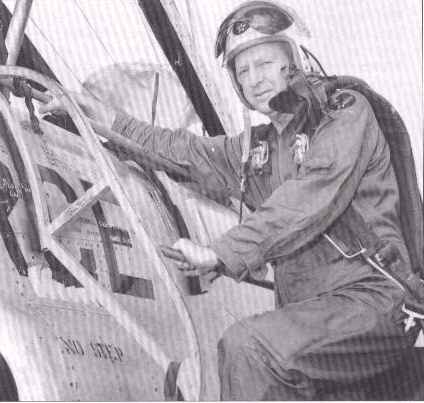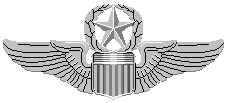
|
General Mundy boarding F-106, which he flew
at Mach 2.07
|
George
W. Mundy was born on August 7, 1905 in Cedartown,
Georgia, a town located in the northwestern section
of the state. The Mundy name is still prominent in
Cedartown today. A nephew, George E., is a senior
member of a prominent law firm there.
George
attended Emory University in Georgia through the 1923-24
session. He war then appointed to the United States
Military Academy at West Point, from which he graduated
with a BS degree in 1928.
Among
his classmates at West Point was William Tunner, prominent
in the Air Transport Command during World War II.
He gained further distinction in 1948 for his role
in setting up and commanding the Berlin Airlift.
Other
classmates included Emmett "Rosie" O'Donnell, Ted
Landon and Sam Anderson, all of whom became outstanding
Air Force leaders and attained a four star rank.
Mundy
fondly remembers many other good friends from those
early days, all of whom would reach prestigious positions
in the Air Force - "Possum" Hansell, Tom Power, "Shorty"
Wheless - and Kenneth Wolfe, though he was a few years
older.
After
graduation from the Academy, George Mundy was commissioned
a Second Lieutenant in the Field Artillery on 9 June
1928. In July of that year, he entered pilot training
at Brooks and Kelly Field, Texas. At Brooks he flew
the PT-3 and the DH-4,
and at Kelly he received his advanced training in
the P-l, A-3, B-2 and 0-1. Upon completion in 1929,
he was transferred to the Army Air Corps.
While
at flying school, Mundy met and became lifelong friends
with fellow classmate, Curtis LeMay. Destiny would
reunite them again on 17 March 1945. On that date,
Mundy would become leader of the 39th Bomb Group on
Guam under LeMay who had been named 20th Air Force
Commander only two months earlier.
On
2 March 1934, George was promoted to the regular Army
rank of First Lieutenant. This first promotion was
followed on 9 June 1958 was followed by another elevation
in grade to Captain in the regular Army.
Other
promotions came regularly. On 1 February 1941, he
gained the rank of Major, Air Corps, followed by Lieutenant
Colonel on 23 January of the following year. On 9
May 1942, he became Colonel, Air Corps, and finally
on 28 August 1943, he attained the rank of Colonel,
AUS.
His
first assignment upon graduation from pilot training
school was as squadron officer with the 13th Attack
Squadron, 3rd Attack Group, Fort Crockett, Texas.
He held this position from October 1929 until September
1930, when he entered the Army Air Force Technical
School at Chanute Field, Illinois. Upon leaving there
in April of 1931, he rejoined the 3rd Attack Group
at Fort Crockett.
In
1934, First Lieutenant Mundy married Suzanne Buck,
a daughter of Major General E. B. Buck, a West Point
graduate and World War I hero. Buck had entered the
war as a Colonel in charge of a Regiment, was soon
elevated to Brigadire Commander, and finally was given
a division serving directly under General Pershing.
The
Mundys had a daughter, Janice, who in keeping with
her military heritage, went on to marry an Air Force
doctor. They had four daughters and A son, and at
the moment General Mundy has five great-grandchildren.
An
exciting and memorable experience occurred in the
earlier days of George Mundy's career:
In
or about 1934, President Franklin Roosevelt suddenly
cancelled all air mail contacts and ordered the Army
Air Corps to take over these routes. Lieutenant Mundy's
assignment was the mail run from Omaha to Cheyenne
to Salt Lake City and return. His aircraft was a primitive
two place open cockpit A-12.
On
a cold, wintry day, he ran into inclement weather
on the Cheyenne to Salt Lake City leg of his route.
Better judgment persuaded the young pilot to return
to Cheyenne. While in the midst of unloading his
mail for transfer to rail shipment, a fellow flier
flew in from Salt Lake City. This persuaded Mundy
to give it another try. Once again, he ran into
nasty conditions, but rather than turn back a second
time, he dropped down to a very low altitude with
the intention of flying visually along the railroad
tracks leading into Ogden, Utah, and then continue
on down to Salt Lake City. However, the ceiling
continued to drop lower and lower, and as he rounded
a turn, he ran headlong into a raging snowstorm!
The
steep sided canyon was too narrow to make a 180-degree
turn, so the only option was to climb sharply on
instruments. He had managed to reach 10,000 feet
(fortunately), when his gyro instruments and air
speed indicator both froze. Without visual reference
or operable instruments, there remained no way to
fly the airplane!
Today's
aircraft all have heated pitot tubes to prevent
freezing, but this was 1934 and instrument technology
was in its infancy.
Only
by extreme daring and willpower did he manage to
take both his hands and feet off the controls and
let the airplane fly itself - praying that it would
climb upward rather than pulled downward.
Fortunately
the altimeter was still operative so he was able
to keep a close watch on his altitude. If that too
had failed, there would have been no choice but
to bail out into the cold and hostile terrain below
an action that would have, most likely, had a tragic
ending.
After
what seemed to be an eternity of uncertainty, the
A-12 wallowed up to around 13,00O feet - then broke
out above the cloud mass. Once on top, Mundy struck
a course for Salt Lake City. Since the weather there
was VRF there was no problem in landing safely.
This had been an exhausting, as well as nerve-wracking
ordeal. Old "Mother Earth" never looked any better.
On
the bus taking him to the hotel. Lieutenant Mundv
related to a friend his harrowing experience. It
was decided that a good stiff drink might help -
and it did. Mundv flopped onto the bed and immediately
fell asleep for the following 24 hours! There was
no insomnia that night.
In
January 1935, he departed for the Philippine Islands,
where he became a Squadron officer with the 2nd Observation
Squadron of the 4th Composite Group at Nichols Field.
The
following ten years saw many transfers and new assignments
for the young Air Corps officer. From December 1936
until January 1939, he was a staff officer with the
3rd Attack Group then stationed at Barksdale, La.
In
January 1939, he entered the AAF Technical School
at Maxwell Field, Ala. From October of that year until
July 1941, he was a Squadron Commander and staff officer
with the 23rd Composite Group, first at Maxwell Field,
and later at Orlando, Florida.
In
January 1941, he was sent to London, England as a
military observer, returning in October of that year.
He was then given command of the 23rd Composite Group
at Eglin Field, Florida. He was relieved of this assignment
the following month to become Commanding Officer of
the Air Corps Proving Grounds at Eglin Field. He remained
in this position until April 1942 when he became CO
of the Twin Engine Fighter School at George Field,
Illinois.
Mundy [ 1
] [ 2 ] [ 3
] [ 4 ] [ 5
] [ 6 ]







